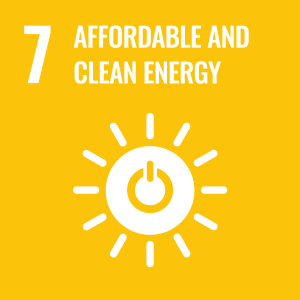
Dr Hashini Perera
Academic and research departments
Nanoelectronics Centre, Advanced Technology Institute, School of Computer Science and Electronic Engineering.News
In the media
ResearchResearch interests
Perovskites, Photovoltaics, Renewable Energy, Optoelectronics
Research interests
Perovskites, Photovoltaics, Renewable Energy, Optoelectronics
Sustainable development goals
My research interests are related to the following:




Publications
The development of perovskite solar cells (PSCs) with low recombination losses at low processing temperatures is an area of growing research interest as it enables compatibility with roll-to-roll processing on flexible substrates as well as with tandem solar cells. The inverted or p–i–n device architecture has emerged as the most promising PSC configuration due to the possibility of using low-temperature processable organic hole-transport layers and more recently, self-assembled monolayers such as [4-(3,6-dimethyl-9H-carbazol-9-yl)butyl]phosphonic acid (Me-4PACz). However, devices incorporating these interlayers suffer from poor wettability of the precursor leading to pin hole formation and poor device yield. Herein, the use of alumina nanoparticles (Al2O3 nanoparticles (NPs)) for pinning the perovskite precursor on Me-4PACz is demonstrated, thereby improving the device yield. While similar wettability enhancements can also be achieved by using poly[(9,9-bis(3′-((N,N-dimethyl)-N-ethylammonium)-propyl)-2,7-fluorene)-alt-2,7-(9,9-dioctylfluorene)]dibromide (PFN-Br), a widely employed surface modifier, the incorporation of Al2O3 NPs results in significantly enhanced Shockley–Read–Hall recombination lifetimes exceeding 3 μs, which is higher than those on films coated directly on Me-4PACz and on PFN-Br-modified Me-4PACz. This translates to a champion power conversion efficiency of 19.9% for PSCs fabricated on Me-4PACz modified with Al2O3, which is a ≈20% improvement compared to the champion device fabricated on PFN-Br-modified Me-4PACz.
Managing iodine formation is crucial for realising efficient and stable perovskite photovoltaics. Poly(3,4-ethylenedioxythiophene)polystyrene sulfonate (PEDOT:PSS) is a widely adopted hole transport material, particularly for perovskite solar cells (PSCs). However, improving the performance and stability of PEDOT:PSS based perovskite optoelectronics remains a key challenge. We show that amine-containing organic cations de-dope PEDOT:PSS, causing performance loss, which is partially recovered with thiocyanate additives. However, this comes at the expense of device stability due to cyanogen formation from thiocyanate–iodine interaction which is accelerated in the presence of moisture. To mitigate this degradation pathway, we incorporate an iodine reductant in lead–tin PSCs. The resulting devices show an improved power conversion efficiency of 23.2% which is among the highest reported for lead–tin PSCs, and ∼66% enhancement in the TS80 lifetime under maximum power point tracking and ambient conditions. These findings offer insights for designing next-generation hole extraction materials for more efficient and stable PSCs.
Self-assembled monolayers (SAMs) are a popular choice for achieving high-efficiency perovskite solar cells (PSCs). However, the incomplete wetting of the perovskite on (4-(3,6-dimethyl-9H-carbazol-9-yl)butyl)phosphonic acid (Me-4PACz) SAMs in PSCs has proven to be a challenge. Recently, the use of surface modifiers such as alumina nanoparticles and poly(9,9-bis(3′-(N,N-dimethyl)-N-ethylammonium-propyl-2,7-fluorene)-alt-2,7-(9,9-dioctylfluorene))dibromide (PFN–Br) has been demonstrated to eliminate this bottleneck. However, the influence of these surface modifiers on device stability has not been reported. Here, we studied the influence of alumina nanoparticles and PFN–Br on Me-4PACz device stability when stressed under ISOS-D-2I and ISOS-D-2 conditions (at 65 °C). The use of alumina nanoparticles leads to efficient scavenging of iodine, improved bulk electrical and surface electronic homogeneity in fresh films, which is preserved even when the films are degraded, and the formation of 2D perovskites, which act as a barrier against moisture induced degradation. In comparison, perovskites based on PFN–Br show a distinct lack of similar characteristics for fresh and degraded samples. This allows the realisation of alumina modified Me-4PACz based PSCs with a tenfold improved T80 lifetime of 1530 h under ISOS-D-2 conditions compared to the PFN–Br based device stack. Our study uncovers a new approach towards enhancing PSC stability, which could potentially be applied under more strenuous ISOS test conditions to further improve device stability.
Over the last decade, 2,2″,7,7″-Tetrakis[N,N-di(4-methoxyphenyl)amino]-9,9′-spirobifluorene (spiro-OMeTAD) has remained the hole transporting layer (HTL) of choice for producing high efficiency perovskite solar cells (PSCs). However, PSCs incorporating spiro-OMeTAD suffer significantly from dopant induced instability and non-ideal band alignments. Herein, a new approach is presented for tackling these issues using the functionality of organometallocenes to bind to Li+ dopant ions, rendering them immobile and reducing their impact on the degradation of PSCs. Consequently, significant improvements are observed in device stability under elevated temperature and humidity, conditions in which ion migration occurs most readily. Remarkably, PSCs prepared with ferrocene retain 70% of the initial power conversion efficiency (PCE) after a period of 1250 h as compared to only 8% in the control. Synergistically, it is also identified that ferrocene improves the hole extraction yield at the HTL interface and reduces interfacial recombination enabling PCEs to reach 23.45%. This work offers a pathway for producing highly efficient spiro-OMeTAD devices with conventional dopants via addressing the key challenge of dopant induced instability in leading PSCs.
Within a short time span of a little over a decade, single junction metal halide perovskites have emerged as perhaps the semiconductor type that has shown the fastest growth in the history of photovoltaic technologies. In addition to its potential applications for single junction architectures, the bandgap tunability of perovskites through compositional engineering to realise both wide and narrow bandgap absorbers have made perovskites an attractive candidate for the development of tandem architectures. Indeed, this led multijunction cell concepts exceed the theoretical limits for single junction silicon photovoltaics while rapidly approaching the limits for other high efficiency single junction absorbers. Within this chapter, we outline the developments made in perovskite/silicon, perovskite/copper–indium–gallium–selenide (CIGS), perovskite/perovskite and emerging triple junction concepts that are based either on a combination of three perovskite absorbers or perovskite/perovskite/silicon type configuration. Particular attention is paid towards modification of interfacial properties for optimising charge extraction and light coupling, the bulk properties for stabilisation of the different perovskite bandgaps and processing strategies that address the challenges that arise during the deposition of perovskites on textured bottom cells such as silicon and CIGS. Finally future directions for research are proposed. This includes the consideration of factors that can accelerate the degradation of perovskites when processing under less well controlled environments as well as considerations for upscaling.